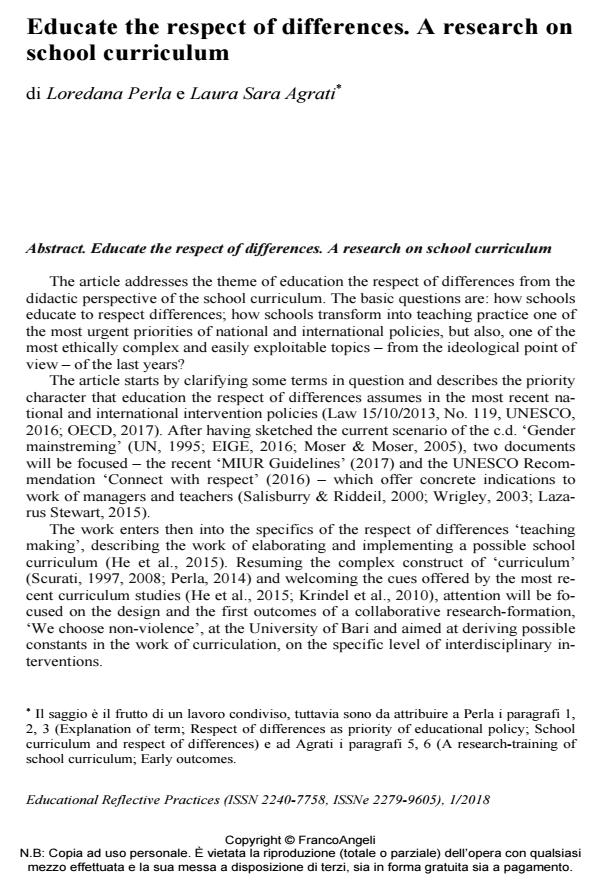Educate the respect of differences. A research on school curriculum
Journal title EDUCATIONAL REFLECTIVE PRACTICES
Author/s Loredana Perla, Laura Sara Agrati
Publishing Year 2018 Issue 2018/1
Language English Pages 27 P. 25-51 File size 349 KB
DOI 10.3280/ERP2018-001003
DOI is like a bar code for intellectual property: to have more infomation
click here
Below, you can see the article first page
If you want to buy this article in PDF format, you can do it, following the instructions to buy download credits

FrancoAngeli is member of Publishers International Linking Association, Inc (PILA), a not-for-profit association which run the CrossRef service enabling links to and from online scholarly content.
The article addresses the theme of education the respect of differences from the didactic perspective of the school curriculum. The basic questions are: how schools educate to respect differences; how schools transform into teaching practice one of the most urgent priorities of national and international policies, but also, one of the most ethically complex and easily exploitable topics - from the ideological point of view - of the last years? The article starts by clarifying some terms in question and describes the priority character that education the respect of differences assumes in the most recent na-tional and international intervention policies (Law 15/10/2013, No. 119, UNESCO, 2016; OECD, 2017). After having sketched the current scenario of the c.d. ‘Gender mainstreming’ (UN, 1995; EIGE, 2016; Moser & Moser, 2005), two documents will be focused - the recent ‘MIUR Guidelines’ (2017) and the UNESCO Recom-mendation ‘Connect with respect’ (2016) - which offer concrete indications to work of managers and teachers (Salisburry & Riddeil, 2000; Wrigley, 2003; Laza-rus Stewart, 2015).-The work enters then into the specifics of the respect of differences ‘teaching making’, describing the work of elaborating and implementing a possible school curriculum (He et al., 2015). Resuming the complex construct of ‘curriculum’ (Scurati, 1997, 2008; Perla, 2014) and welcoming the cues offered by the most re-cent curriculum studies (He et al., 2015; Krindel et al., 2010), attention will be fo-cused on the design and the first outcomes of a collaborative research-formation, ‘We choose non-violence’, at the University of Bari and aimed at deriving possible constants in the work of curriculation, on the specific level of interdisciplinary in-terventions. The aim is to suggest to the didactic research some evidence based discussion contents in order to corroborate or refute the sometimes surreptitious statements (Peeters, 2012) on the topic; to schools, educational and didactic intervention crite-ria consistent with general policies, scientifically founded but above all humanly useful.
Loredana Perla, Laura Sara Agrati, Educate the respect of differences. A research on school curriculum in "EDUCATIONAL REFLECTIVE PRACTICES" 1/2018, pp 25-51, DOI: 10.3280/ERP2018-001003